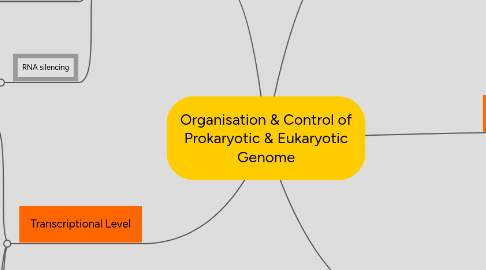
1. Transcriptional Level
1.1. Change in structure of DNA (packing)
1.1.1. Modification of chromatin structure
1.1.1.1. DNA methylation
1.1.1.1.1. Formation of CpG islands in promoter region
1.1.1.2. Histone modification
1.1.1.2.1. Acetylation
1.1.1.2.2. Deacetylation
1.2. Control elements
1.2.1. Promoters + TATA box (-20 to -30)
1.2.1.1. Bind general transcription factors
1.2.2. Distal
1.2.2.1. Enhancers
1.2.2.1.1. Bind activators
1.2.2.2. Silencers
1.2.2.2.1. Bind repressors
1.3. Combinatorial control of gene expression
1.3.1. Variation in types of numbers of control elements & specific transcription factors
1.3.2. Coordinately controlled genes
1.3.2.1. Eukaryotic form of 'operon model'
1.3.2.1.1. Promote simultaneous transcription of certain related genes
1.3.2.1.2. Eg. By signal transduction
2. Translational Level
2.1. Half-life of RNA
2.1.1. 5' cap + 3' poly-A-tail
2.1.2. 5' and 3' UTRs
2.1.2.1. Varying sequences affect the affinity of mRNA for RNAses
2.2. Varying abundance & activity of eIFs
2.2.1. Widespread effect on all translation activity
2.2.2. Activation/Inactivation by phosphorylation/dephosphorylation
2.3. Regulatory proteins
2.3.1. Bind at 5' UTR to prevent binding of eIFs & ribosome
2.4. RNA silencing
2.4.1. siRNAs (dsRNA)
2.4.1.1. Cleaved by Dicer
2.4.1.1.1. Associates with RISC (RNA induced silencing complex)
2.4.2. miRNAs (ssRNA)
2.4.2.1. Pair with mRNA
2.4.2.1.1. Block translation
2.4.2.1.2. Target for degradation
3. Level of Genetic Code
3.1. Increase in number of copies of genes
3.2. VIA
3.2.1. Gene Amplification
3.2.1.1. Repeated firing of multiple DNA replication origins
3.2.1.2. Unequal chromosomal exchange between 2 non-sister chromatids
3.2.1.2.1. Due to: Incorrect synapsing of bivalents
3.2.1.3. Chromosomal breakage across 2 sister chromatids
3.2.1.3.1. Frayed ends which fuse and break apart during anaphase unequally
3.2.1.4. Slippage during DNA replication leading to folding back of the strand
4. Post-Transcriptional Level
4.1. Pre-mRNA --> Mature mRNA
4.2. 5' 7-methylguanosine cap
4.2.1. Prevents degradation by RNAses
4.2.2. Recognition of mature mRNA by ribosome
4.3. 3' poly-A-tail (200 A)
4.3.1. Stabilize mRNA: Length regulates lifespan of mRNA & polypeptide yield
4.4. Splicing
4.4.1. Splicing out of introns
4.4.2. Splicing together of exons
4.4.3. Enables alternative splicing of mRNA
4.4.3.1. One gene/mRNA encodes many different polypeptides
4.5. Editing of mature mRNA
4.5.1. Modifying of nucleotide sequence
5. Post Translational Level
5.1. Attachment of functional groups (eg. phosphate)
5.1.1. Via enzymes such as kinases
5.2. Structural changes to polypeptide (Eg. preproinsulin)
5.3. Protein degradation by ubiquitin in proteasome
5.3.1. Eg. cyclins
